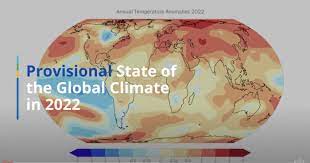
STATE OF THE GLOBAL CLIMATE 2022 REPORT
STATE OF THE GLOBAL CLIMATE 2022 REPORT I RACE IAS : Best IAS Coaching in Lucknow I Current Affairs
Mains Examination: General Studies 3
(Environmental pollution and degradation)
Why inNews:
- Recently, the State of the Global Climate Report 2022 has been released by the World Meteorological Organisation.
- The 'State of the Global Climate 2022' report released by WMO states that the sea level is rising at an unprecedented rate.
- The report mainly focuses on climate indicators greenhouse gas, temperature, sea level rise, ocean warming and acidification, sea ice and glaciers. It also throws light on the effects of climate change and weather events.
Important facts related to the report:
- The rate of global average sea-level rise has doubled over three decades, from 2.27 mm/year in 1993-2002 to 4.62 mm/year in 2013-2022.
- The global average temperature in the year 2022 has increased by 1.15 degree Celsius compared to the pre-industrial era (1850-1900).
- The eight years from 2015 to 2022 were the warmest. In addition, global temperatures in 2021 and 2022 were much warmer than in 2011, although last year's La Niña event significantly affected this.
- In 2022 Ocean Heat Content (OHC) set a new record. About 90% of the energy trapped in the climate system by greenhouse gases goes into the ocean.
- In 2022, at least 58 percent of the ocean surface experienced an ocean heat wave event and at least 25 percent of the surface experienced an ocean cold wave event.
- The concentration of the three main greenhouse gases - carbon dioxide, methane and nitrous oxide - reached a record high in the year 2021.
- Ocean acidification: The global average ocean pH value is steadily declining at rates not seen for at least the last 26,000 years.
- During the years 2005 to 2019, there was a huge loss of glaciers in Greenland and Antarctica. The melting of these glaciers has increased the sea level by an average of 36 percent. It is noteworthy that water expands due to the warming of the sea. In such a situation, this event has contributed 55 percent to the increase in the global average sea level.
- During 2022, while East Africa experienced persistent drought, heatwave severity peaked in China and Europe with record rainfall in Pakistan. Record rains in Pakistan affected more than 33 million people. More than 15,000 people died in heatwaves in Europe and China, and in Spain, Germany, the United Kingdom, France and Portugal.
Reasons for the Rapid rise in the Sea level:
As reported during 2005-2019:
- Increase in frequency of cyclones: This will affect coastal communities and cause huge economic liabilities for tropical countries like India and South Africa with high population density. For example, South Africa was hit by five cyclones in two months in 2022.
- Groundwater salinization: More seawater can seep into the ground, causing groundwater – which is usually fresh water – to become more and more saline. This in turn may exacerbate water stress in agriculture in the coastal areas as well as in the adjacent areas.
- Forced Migration: Coastal ecosystems have been "completely transformed". In the Sundarbans delta in West Bengal, rising sea levels and coastal erosion have forced members of local communities to migrate.
- Record-breaking rains: Pakistan was hit by widespread flooding, leading to a massive rise in water levels. Record-breaking heat waves hit Europe during the summer. China had the most widespread and long-lasting heatwave since national records began
- Food insecurity: By 2021, 2.3 billion people are expected to face food insecurity due to extreme climate change, of which 924 million will face severe food insecurity.
Figures of this report with reference to India:
- According to the all India weather forecast issued by the India Meteorological Department (IMD) on April 19, 2023:
- On April 18, 2023, more than 60 per cent of India or 22 states and union territories recorded maximum maximum temperature above normal.
- According to the data of the Meteorological Department, between 2003 to 2012 and 2013 to 2022, there was a 34 percent increase in deaths due to heat.
- According to a Cambridge University study, 90 per cent of the country's population is at risk of loss of livelihoods, food yields, vector-borne disease outbreaks and urban sustainability due to the heat.
- Note that, when the maximum temperature of a station reaches at least 40°C in plains, at least 37°C in coastal areas and at least 30°C in hilly areas, it is declared as a heatwave. Is.
- According to a report by McKinsey Global Institute, if the occurrence of heat waves in India continues like this, then by 2030, the country may suffer a loss of 2.5 to 4.5 percent of its gross domestic product (GDP) per year.
- March 2022 was the warmest ever and the third driest in 121 years.
About World Meteorological Organization (WMO):
- It is an inter-governmental organization with a membership of 193 member states and territories.
- The headquarters of this organization is in Geneva.
- It traces its origins to the International Meteorological Organization (IMO), which traces its roots to the 1873 Vienna International Meteorological Congress.
- This organization was established in 1950 by ratification of the WMO Convention, WMO is a specialized agency of the United Nations for meteorology (weather and climate), operational hydrology and related geophysical sciences.
------------------------------------------------------------